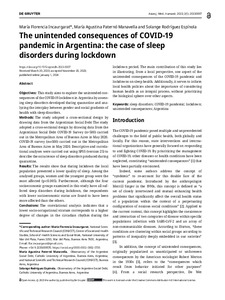Por favor, use este identificador para citar o enlazar este ítem:
https://repositorio.uca.edu.ar/handle/123456789/20357| Campo DC | Valor | Lengua/Idioma |
|---|---|---|
| dc.contributor.author | Incaurgarat, María Florencia | es |
| dc.contributor.author | Paternó Manavella, María Agustina | es |
| dc.contributor.author | Rodríguez Espínola, Solange | es |
| dc.coverage.spatial | Argentina | es |
| dc.date.accessioned | 2025-08-21T17:20:12Z | - |
| dc.date.available | 2025-08-21T17:20:12Z | - |
| dc.date.issued | 2023 | - |
| dc.identifier.issn | 2751-0069 | - |
| dc.identifier.uri | https://repositorio.uca.edu.ar/handle/123456789/20357 | - |
| dc.description.abstract | Objectives: This study aims to explore the unintended consequences of the COVID-19 lockdown in Argentina by assessing sleep disorders developed during quarantine and analyzing the interplay between gender and social gradients of health with sleep disorders. Methods: The study adopted a cross-sectional design by drawing data from the Argentinian Social Debt The study adopted a cross-sectional design by drawing data from the Argentinian Social Debt COVID-19 Survey (n=500) carried out in the Metropolitan Area of Buenos Aires in May 2020. COVID-19 survey (n=500) carried out in the Metropolitan Area of Buenos Aires in May 2020. Descriptive and correlational analyses were carried out using SPSS (version 25) to describe the occurrence of sleep disorders produced during quarantine. Results: The results show that during lockdown the local population presented a lower quality of sleep. Among the analysed groups, women and the youngest group were the most affected (p<0.005). Furthermore, although the four socioeconomic groups examined in this study have all suffered sleep disorders during lockdown, the respondents with lower socioeconomic status are found to have been more affected than the others. Conclusions: The correlational analysis indicates that a lower socio-occupational stratum corresponds to a higher degree of changes in the circadian rhythm during the lockdown period. The main contribution of this study lies in illustrating, from a local perspective, one aspect of the unintended consequences of the COVID-19 pandemic and lockdowns on sleep health. Additionally, it serves to inform local health policies about the importance of considering human health as an integral process, without prioritizing the biological sphere over other aspects. | es |
| dc.format | application/pdf | es |
| dc.language.iso | eng | es |
| dc.publisher | De Gruyter Brill | es |
| dc.rights | Atribución-NoComercial-CompartirIgual 4.0 Internacional | * |
| dc.rights.uri | http://creativecommons.org/licenses/by-nc-sa/4.0/ | * |
| dc.source | Asian Journal of Medical Humanities. 2(1), 2023. | es |
| dc.subject | TRASTORNOS DEL SUEÑO | es |
| dc.subject | PANDEMIA | es |
| dc.subject | COVID-19 | es |
| dc.title | The unintended consequences of COVID-19 pandemic in Argentina: the case of sleep disorders during lockdown | es |
| dc.type | Artículo | es |
| dc.identifier.doi | 10.1515/ajmedh-2023-0007 | - |
| uca.issnrd | 1 | es |
| uca.affiliation | Fil: Incaurgarat, María Florencia. Consejo Nacional de Investigaciones Científicas y Técnicas; Argentina | es |
| uca.affiliation | Fil: Incaurgarat, María Florencia. Universidad Nacional de Mar del Plata; Argentina | es |
| uca.affiliation | Fil: Paternó Manavella, María Agustina. Pontificia Universidad Católica Argentina. Observatorio de la Deuda Social Argentina; Argentina | es |
| uca.affiliation | Fil: Paternó Manavella, María Agustina. Consejo Nacional de Investigaciones Científicas y Técnicas; Argentina | es |
| uca.affiliation | Fil: Rodríguez Espínola, Solange. Consejo Nacional de Investigaciones Científicas y Técnicas; Argentina | es |
| uca.version | publishedVersion | es |
| item.grantfulltext | open | - |
| item.fulltext | With Fulltext | - |
| item.languageiso639-1 | en | - |
| crisitem.author.dept | Observatorio de la Deuda Social Argentina | - |
| crisitem.author.dept | Observatorio de la Deuda Social Argentina | - |
| crisitem.author.orcid | 0000-0002-9557-532X | - |
| crisitem.author.orcid | 0000-0003-2545-8483 | - |
| crisitem.author.parentorg | Pontificia Universidad Católica Argentina | - |
| crisitem.author.parentorg | Pontificia Universidad Católica Argentina | - |
| Aparece en las colecciones: | Colaboraciones en ediciones externas | |
Ficheros en este ítem:
| Fichero | Descripción | Tamaño | Formato | |
|---|---|---|---|---|
| unintended-consequences-covid.pdf | 1,14 MB | Adobe PDF |  Visualizar/Abrir |
Este ítem está sujeto a una Licencia Creative Commons

